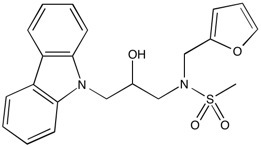KL-001 | Cryptochrome (CRY) activator
NMR (Conforms)

Available Options
| size : | Price | Quantity | |
|---|---|---|---|
| 5 mg | $55.00 | ||
| 25 mg | $200.00 |
KL-001 (309928-48-1) is a novel tool that specifically interacts with cryptochrome (CRY) preventing its ubiquitin-dependent degradation resulting in lengthening of the circadian period. KL-001-mediated CRY stabilization inhibits glucagon-induced gluconeogenesis in primary hepatocytes.1 Binds to the FAD-binding pocket of CRY2 as determined by co-crystal structure.2 KL-001 induces an increase in period along with simultaneous reduction in amplitude of circadian reporter expression3 in mammalian cells.
References/Citations:
1) Hirota et al. (2012), Identification of small molecule activators of cryptochrome; Science, 337 1094
2) Nangle et al. (2013), Crystal structure of mammalian cryptochrome in complex with a small molecule competitor of its ubiquitin ligase; Cell Res., 23 1417
3) St. John et al. (2014), Spatiotemporal separation of PER and CRY posttranslational regulation in the mammalian circadian clock; Proc. Natl. Acad. Sci. USA, 11 2040
NMR (Conforms)
Safety Data Sheet:
Product Data Sheet:
Materials provided by Focus Biomolecules are for laboratory research use only and are not intended for human or veterinary applications. Please note that we do not sell to individuals and that all orders placed by non-research organizations will incur a $20 restocking/refund fee
KL-001 (309928-48-1) is a novel tool that specifically interacts with cryptochrome (CRY) preventing its ubiquitin-dependent degradation resulting in lengthening of the circadian period. KL-001-mediated CRY stabilization inhibits glucagon-induced gluconeogenesis in primary hepatocytes.1 Binds to the FAD-binding pocket of CRY2 as determined by co-crystal structure.2 KL-001 induces an increase in period along with simultaneous reduction in amplitude of circadian reporter expression3 in mammalian cells.
References/Citations:
1) Hirota et al. (2012), Identification of small molecule activators of cryptochrome; Science, 337 1094
2) Nangle et al. (2013), Crystal structure of mammalian cryptochrome in complex with a small molecule competitor of its ubiquitin ligase; Cell Res., 23 1417
3) St. John et al. (2014), Spatiotemporal separation of PER and CRY posttranslational regulation in the mammalian circadian clock; Proc. Natl. Acad. Sci. USA, 11 2040
Related Circadian Clock Products
Download
Calculate the molar concentration, mass or volume in a solution.
Concentration × Volume × Molecular Weight = Mass
Focus Biomolecules • Plymouth Meeting, PA USA • 1-855-FOCUS21
Focus Biomolecules
Plymouth Meeting, PA USA
1-855-FOCUS21
Website Created by Advanta Advertising LLC.

